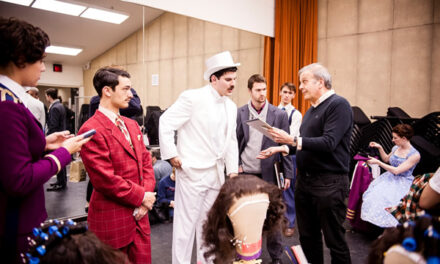St. Mary’s Church was the perfect acoustical setting for the intimate sounds of duo Kate Steinbeck, flutist and artistic director of Keowee Chamber Music, and Amy Brucksch, guitarist. Although the program was billed as a CD Prelude Concert sponsored by Keowee Chamber Music, the women also performed some of their other personal favorites that won’t yet be recorded. “Luminescence,” the title track of the album, is an apt word for the effect their music has on the listener — it lights one from within.
The program consisted entirely of the works of foreign composers, beginning with a set of three Latin-inspired pieces. Jacque Ibert’s “Entr’acte” really set the mood for the remainder of the evening. The repetitive flute melody, at first caught in a narrow range, morphed into an enchanting and rhapsodic incarnation. Like Steinbeck, who frequently closes her eyes when she plays, one is tempted to do the same and just go with it — to wherever. Next came Maurice Ravel’s “Pièce en forme de Habañera” from 1907. Originally written for bass voice and piano, the piece’s languid and sultry melodies worked well for the duo, as did Darius Milhaud’s “Corcovado” from Saudades do Brasil. Brucksch’s guitar, more collaborator than accompanist, alternately established mood or color with interjected strummed chords or melodic bursts. It was clear the two have a history of performing together, for they communicate on many levels, principally through a sophisticated, shared knowledge of where the music is going. Marvelous!
The sonata for flute and continuo S.1033, attributed to J.S. Bach but more likely by C.P.E. Bach, his most famous son, was the evening’s sole concession to a conventional, established major work. Unfolding in 5 movements (Andante, then Presto-Allegro-Adagio-Minuet 1-Minuet 2), its performance demands, especially in the whirling passagework of the fast movements, were more than matched by the duo’s technical prowess. Brucksch’s sonorous guitar, custom made for her by California luthier Gregory Byers, provided a delightful and attentive continuo.
“Midnight Train” for solo guitar by Nadia Borislova, a Russian guitarist active at the School of Fine Arts at Puebla University in Mexico, was a programmatic work about a train’s journey at midnight from Moscow to St. Petersburg. More suggestive than demonstrative, however, the work invited the play of one’s imagination upon hearing its somewhat muted sounds and special effects — a train at a distance, and clearly an audience favorite. Ending the first half was “Macedonian Song” from Four Legends, a lyrical crossover for flute and guitar that hovered between folk and pop song styles.
Dana Wilson’s “Luminescence,” originally for soprano sax and guitar, worked well on an alto flute in G, a fourth lower than her standard flute. The muted breathiness of its timbre matched Wilson’s sultry jazz musings — it wasn’t hard to picture a jazz singer in a smoky nightclub exchanging riffs with the guitarist. The Finnish Suite by Paul Svoboda was cast in four movements — the first three functioned as melodious character pieces/songs without words (“Song is my Joy,” “The Farmer’s Daughter,” “The Sky is Blue and White”), with the fourth (“Who is Going to Heat the Sauna Bath?”) a hilarious, unleashed hoedown. To end the evening the Latin theme was recalled in two catchy Brazilian tunes, a bossa nova and a samba.











